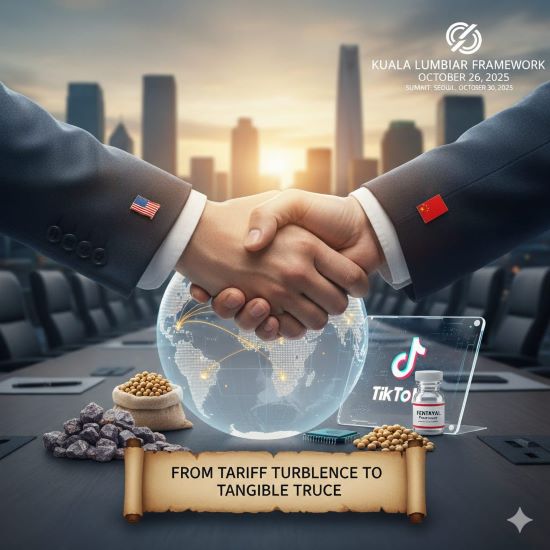 After months of tariff sabre-rattling and rhetorical escalation — or “Trump’s tariff tantrums,” as they have often been described — Washington and Beijing have at last inched back from confrontation. Negotiators from both sides finalised a preliminary agreement on key trade issues in Kuala Lumpur over the weekend. The framework now heads for formal endorsement by President Donald Trump and President Xi Jinping at their October 30, 2025 summit in South Korea.
After months of tariff sabre-rattling and rhetorical escalation — or “Trump’s tariff tantrums,” as they have often been described — Washington and Beijing have at last inched back from confrontation. Negotiators from both sides finalised a preliminary agreement on key trade issues in Kuala Lumpur over the weekend. The framework now heads for formal endorsement by President Donald Trump and President Xi Jinping at their October 30, 2025 summit in South Korea.
This is no grand bargain. It is a calculated pause — an exercise in mutual restraint meant to avert immediate economic damage, not only to both countries but also to the wider global system. In the modern era of nationalist economics, preventing crisis often counts as progress, and this is one of those textbook cases.
Rare Earths: The Core of Compromise
At the centre of the accord is a critical trade-off. China will defer its new export controls on rare earth minerals—materials essential for U.S. defence, clean-energy and electronics industries—for at least a year. In return, the United States will suspend the threatened 100 per cent tariffs on Chinese imports that were to take effect on November 1.
This quid pro quo averts a shock to global supply chains. Rare earths are not merely another commodity; they are the quiet enablers of technological modernity. By easing controls, Beijing signals tactical moderation, while Washington gains breathing space for manufacturers struggling with input costs.
Tariffs Frozen, Time Bought
The extension of the 90-day tariff truce is equally consequential. U.S. tariffs on Chinese goods remain capped at 30 per cent, while China’s retaliatory duties hold at 10 per cent.
For markets, that stability is priceless. It gives companies time to plan shipments, hedge currencies and manage inventories. Both economies effectively buy time—postponing confrontation without conceding principle. In trade diplomacy, delay can sometimes be design.
Soybeans and Statesmanship
Agriculture provides the political ballast. Beijing’s pledge to resume large-scale purchases of U.S. soybeans and other farm goods may revive a sector battered by declining exports.
For President Trump, the move validates his tough-talk narrative before America’s farming heartland. For China, it is a low-cost gesture that improves atmospherics ahead of the summit. Yet experience warns that purchase promises are easily announced and slowly fulfilled; only verifiable data will prove that politics has turned into policy.
Fentanyl: Quiet Cooperation on a Deadly Front
Beyond tariffs, the agreement includes a joint effort to curb fentanyl precursor chemicals, a key component in America’s opioid epidemic. This is a modest but humane success. If both governments follow through, it could mark a rare intersection where geopolitics serves public health. Such practical collaboration reminds the world that global governance can still save lives when ideology takes a back seat.
Technology: Managed Decoupling and the TikTok Sidebar
On technology, the two sides have opted for realism over confrontation. Washington will retain export controls on strategic technologies linked to national security but allow non-strategic chips and software to flow again.
Parallel to this, a separate TikTok agreement will be formalised at the Xi–Trump summit, settling months of regulatory uncertainty. These arrangements embody a new paradigm of managed decoupling—commercial coexistence within clearly policed boundaries. For global firms, it means living with two digital ecosystems and planning for compliance in both.
Compliance and Credibility
The accord’s durability will hinge on enforcement. The U.S. Trade Representative has already reopened investigations under Section 301 into China’s compliance with past pledges, including the 2020 “Phase One” deal.
If handled transparently, such mechanisms can turn disputes into scheduled reviews rather than crises. But they must avoid politicisation. A truce held together by trust is fragile; one reinforced by institutional process can endure.
The Structural Fault Lines
The deeper disagreements remain untouched. Intellectual property rights, forced technology transfers, and industrial subsidies—the heart of Washington’s grievances—are still unresolved. Both capitals are effectively managing competition rather than transforming it.

China seeks predictability without surrendering its state-driven model; the United States wants re-industrialisation without igniting inflation. The Kuala Lumpur framework acknowledges those limits, preferring coexistence over collision.
Lessons for India: Calibrated Openness with Guardrails
For India, observing this détente offers valuable cues. New Delhi is exploring its own tariff rationalisation with major partners. A framework fixing broad tariffs between 15 and 17 per cent, with narrow carve-outs for sensitive sectors such as electronics, pharmaceuticals and agri-inputs, could achieve balance—predictability for investors without forfeiting policy space.
Such an approach would work only with transparent review clauses, time-bound exceptions and credible arbitration mechanisms. Combined with logistics reforms, better standards enforcement and faster duty refunds, it could make India a preferred diversification hub for supply chains hedging between Washington and Beijing. The objective is not imitation but intelligent adaptation—learning from others’ stabilisation without inheriting their conflicts.
Stability Through Boring Success
If, by Christmas, rare-earth shipments move uneventfully, soybean cargoes sail as scheduled, TikTok’s ownership dispute is quietly resolved and officials are arguing over audit spreadsheets instead of microphones, the deal will have succeeded.
The Xi–Trump summit in Seoul on October 30 will supply the ceremony, but the true verdict will emerge in the steady hum of unremarkable trade. In geopolitics, dull continuity often signals effective diplomacy.
The Kuala Lumpur framework will not end the U.S.–China rivalry, but it might civilise it. In a fractured world where volatility has become the norm, managed predictability is a victory worth taking.